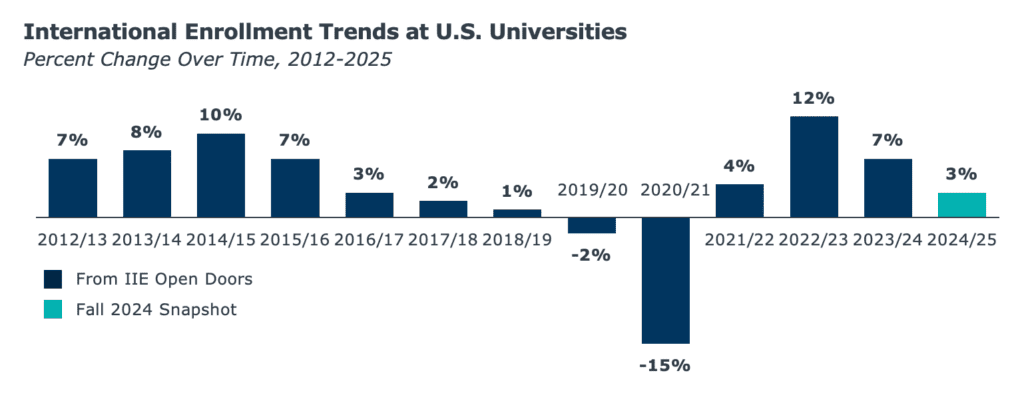Expanding your domestic student market
International students played a major role in post-pandemic enrollment growth, but with the return of a Trump administration, uncertainty now looms for graduate and adult-serving enrollment leaders. Stricter immigration policies in President Trump’s first term significantly slowed growth, and early indicators suggest a similar pattern may emerge. In 2025, institutions must be proactive in adapting their recruitment strategies, placing greater emphasis on domestic student enrollment to maintain stability. Read on to explore key trends, challenges, and strategies to strengthen your domestic lead generation efforts.

Will international enrollment trends reverse?
International students have fueled graduate and adult-serving enrollment in recent years, but several factors now threaten this growth.
Increased investment in STEM programs
STEM fields—especially analytics, computer science, and engineering—have seen significant growth in recent years, especially among international students. According to the 2024 Open Doors report, 56% of international students are enrolled in STEM programs. While these fields remain attractive to domestic students, a decline in international enrollment could slow overall growth in these critical areas.
Emerging international markets
While India and China remain the top sources of international students, secondary markets have been growing. But many of these markets—especially in the Middle East and Africa—are affected by economic and immigration pressures. If further restrictions are enacted, institutions could see a dramatic drop in international students from these regions, as well as others.
Increased budgets for international recruitment
In recent years, institutions have invested heavily in international recruitment. An EAB survey found that 81% of enrollment leaders planned to increase international recruitment efforts between 2021 and 2024. By fall 2023, 57% of U.S. institutions reported an increase in international enrollment. Now, with potential policy shifts on the horizon, institutions must decide whether to continue these investments or reallocate funds to domestic recruitment strategies.
-
81%
of enrollment leaders planned to increase international recruitment efforts between 2021 and 2024
Three challenges of domestic lead generation, and how to solve them
With international enrollment in question, focusing on domestic student recruitment is crucial. Unfortunately, reaching this audience presents its own set of challenges.
Problem 1: Finding enough leads
Graduate and adult-serving programs face intense competition for a shrinking pool of prospective students. Standardized test-taker lists have declined in effectiveness due to test-optional policies, as the number of graduate test-takers went down 46% from 2017 to 2021. Institutions must now seek alternative lead sources to fulfill their enrollment goals.
Solution: Build a strong top-of-funnel and diversify lead sources
With the potential for fewer international students, institutions must expand their domestic top-of-funnel. Leveraging “known sources” such as recent graduates, alumni with college-age children, and alumni of specific cornerstone programs can help with this. Because these leads already have a level of familiarity with your institution, they may be more likely to engage with your marketing efforts.
Diversifying your lead generation source pool is also key. Institutions should explore a mix of traditional and emerging channels to maintain a steady flow of high-quality leads. Of particular importance are sources that can yield high-intent leads, such as Appily Advance, EAB’s graduate and adult lead generation solution. Not only is Appily able to source a high volume of leads, but Appily leads respond 25% faster than schools’ inquiry pools.
-
+25%
Appily Advance leads respond 25% faster than leads from schools’ inquiry pools.
Problem 2: Concerns around cost and ROI
Finances are a top barrier for domestic students. The 2024 EAB Adult Learner Survey found that 36% of prospective domestic graduate and adult students cited program costs as their biggest concern, with 40% unwilling to pay more than $1,500 for a course. And while increasing earning potential is a key motivator, students remain hesitant about the financial return on investment (ROI) of a graduate degree.
-
36%
of prospective domestic grad & adult learners cited program costs as their biggest barrier for returning to school
Solution: Optimize program pages and refine messaging
Since most domestic students conduct independent research, program pages must be:
- Findable: Optimized for SEO and social media.
- Navigable: Easy to explore, with clear branding and a user-friendly design.
- Resourceful and relatable: Answering important student questions and providing social proof.
- Lead capture engines: Strategically placing inquiry forms to collect prospective student information where possible.
Tailoring your messaging to student priorities is equally important. The 2024 Adult Learner Survey found that while career advancement is a key driver, students also value affordability, financial aid, and flexible learning options. Aligning program messaging with these decision criteria can increase engagement and conversions.
Problem 3: Stealth shopping behavior
80% of today’s prospective graduate and adult students are stealth shoppers, meaning that they conduct extensive independent research before ever engaging with an institution. Over half of domestic students prefer to compare programs on their own before reaching out, making a strong digital presence and effective messaging more important than ever. And nearly 40% of prospective graduate and adult students spend at least one year researching programs before applying, complicating your ability to know when your leads might enroll.
Solution: Address value concerns in marketing
A 2024 EAB survey of enrollment leaders found that over half cited “perception of poor ROI” as a major obstacle to enrollment. To counteract this and generate leads effectively, institutions must emphasize program value through:
- Highlighting program accreditation: Clearly displaying accreditation status on program pages and marketing materials can increase trust and credibility, making students more confident in their decision to enroll.
- Making cost and financial aid information accessible: Students are seeking transparency around tuition costs, available scholarships, and financial aid options. Highlighting potential return on investment, such as job placement rates, can also help mitigate concerns about affordability.
- A/B testing marketing messages: Experiment with different resonant messaging themes—affordability, career advancement, scholarships—to determine what resonates most with your audience of prospective students. Iterate on successful ads to ensure your creative stays fresh and effective.
In the wake of potential international enrollment headwinds, institutions must be prepared to adapt their recruitment strategies to stay competitive. By diversifying sources, optimizing program pages, and addressing value concerns, institutions can navigate ensuring long-term success in an uncertain global landscape.

More Blogs

What changed in the graduate lead gen landscape in 2025

We secret shopped 40 graduate programs’ lead nurturing campaigns. Here’s what we learned.
